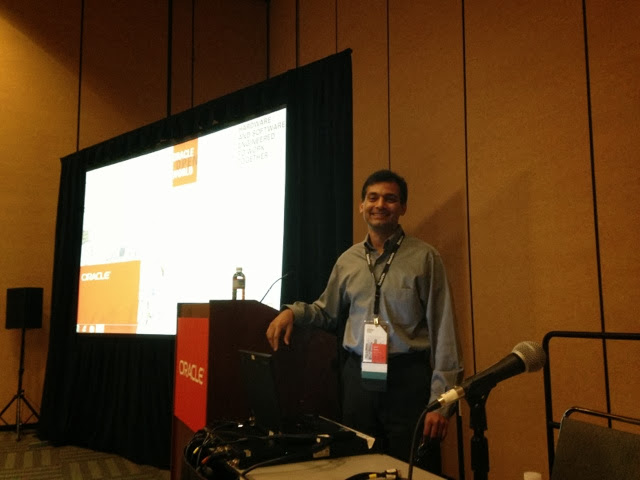Sunday, September 22, 2013
Fusion co-existence session - OOW 2013
Successfully completed delivering my session on Fusion co-existence. Energetic discussion on options for migration and what would be the right roadmap.
OOW 2013 - it's all about the cloud
This year seems to be all about the cloud. Last years emphasis on hardware appears to have waned.
The sub theme is platform with a focus on applications.
Sunday, September 30, 2012
Thursday, June 7, 2012
Oracle Announces Cloud Offering
Larry
Ellison announced the official release of the Oracle Cloud on Wednesday (6/6/2012).
The highlights of his announcement were:
CRM to SRM:
Oracle
is looking to extend the definition of Customer Relationship Management (CRM)
to Social Relationship Management (SRM).
Conceptually this implies looking beyond existing customers, to potential customers. Oracle’s
cloud platform provides hooks to Facebook / Twitter / LinkedIn to facilitate
this approach.
Cloud Infrastructure Services:
Oracle
announced its own Public Cloud. The infrastructure supporting this Cloud
(Security / Monitoring / etc…) is provided as a set of cloud services. The
implication is that these services can be used as infrastructure components to
build out cloud based applications.
HTML 5:
Oracle
cloud based applications (including Fusion Applications) are HTML 5 compliant.
The implication is that they are implicitly mobile-aware. The applications can
run on iPhone / iPad / Android without additional development
PaaS:
Oracle’s
cloud includes Platform as a Service in two areas – Database and J2EE
containers. The implication is that Database “services” can now be provided
on-tap. Also Java applications can be deployed without requiring a parent Java
container to host them.
My key
takeaways were:
- Applications can be moved TO Oracle public cloud, and moved BACK on-premise. There is no vendor lock-in.
- Oracle Cloud Applications (including Fusion) are NOT multi-tenant. Each organization has its own virtual machine and its own data store. Important when it comes to data insulation concerns.
- Upgrades to applications hosted on Oracle public cloud are NOT mandated. Clients can choose when they would like to upgrade, based on their business cycles.
There
was the usual bashing of competitors:
SAP – SAP’s 2020 launch of Cloud based applications for their
SAP suite was ridiculed. The acquisition of SuccessFactors was portrayed as a
way to buy into the cloud arena
Salesforce.com -
Forced upgrades and multi-tenant model was portrayed as a raw deal to
clients
Workday – Their Flash based UI and
object-oriented data model was portrayed as a non-starter. The fact that they
do not have HTML 5 support was seen as an architecturally colossal mistake
Mark
Hurd announced Oracle Platinum Services.
This is a premium support service for Exadata / Exalogic / Exalytics /
SuperCluster.
Friday, June 3, 2011
Oracle's affair with ExaLove

If anyone is following the press around Oracle, it is hard to miss Oracle’s infatuation with Exa. It started with ExaData, the database machine that was so fast it supposedly improved the collective productivity of the human race by 300%. (Of course, these claims are still waiting to be independently validated by IBM).
I had the opportunity to evaluate Exalogic (at close range) recently and I think I am starting to understand the reason behind this excitement. It is not Exadata or Exalogic alone that has got the Oracle Universe a-buzz, it is the possibilities that Exa brings to the IT and business landscape.
I anticipate that post-Exalogic, Oracle will start coming up with a whole host of pre-built appliances that are specialized for a niche area (think data warehouse appliance, BI appliance, sector-specific appliance) while continuing to provide an as-you-want platform in Exalogic.
I can see where the infatuation for “Exa” comes from, and look forward to seeing the vision materialize.
I can see where the infatuation for “Exa” comes from, and look forward to seeing the vision materialize.
Wednesday, March 16, 2011
Manufacturing Clouds - 3D Printing
 A recent article in the technology section of the economist discussed advances in 3D printing. This technology allows users to literally print out objects of everyday use. This “additive” approach to manufacturing as opposed to the traditional approach which is “subtractive” in nature, allows for much more economy in terms of use of raw material. It is also highly custom as each print run can be unique. The cost for each item is limited to the raw material (titanium powder, synthetic plastic, etc…) required for that build. An entire production line does not need to be designed (or modified) for each item that is built.
A recent article in the technology section of the economist discussed advances in 3D printing. This technology allows users to literally print out objects of everyday use. This “additive” approach to manufacturing as opposed to the traditional approach which is “subtractive” in nature, allows for much more economy in terms of use of raw material. It is also highly custom as each print run can be unique. The cost for each item is limited to the raw material (titanium powder, synthetic plastic, etc…) required for that build. An entire production line does not need to be designed (or modified) for each item that is built.When I read this article, it sounded eerily familiar. Traditional IT approaches require a long lead time in terms of design, development, change management and deployment to bring a new application to life. The ultimate purpose of the application is to provide business functionality. If it were possible to build low cost prototypes, or even better, build and retire functionality it would be equivalent to the “additive manufacturing” phenomenon in manufacturing.
Of course, in IT we have the cloud based approach to pay-per-use infrastructure (IaaS). We have pay-per-use functionality in terms of hosted applications (SaaS). We also have pay-per-use platforms for hosting complex applications (PaaS). In this context manufacturing appears to have found its own “Cloud” and the advantages stemming from this change will be nothing short of world changing.
Subscribe to:
Posts (Atom)







